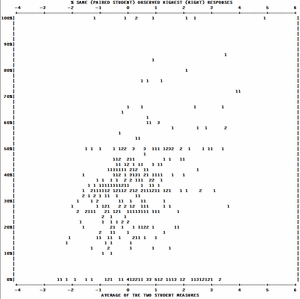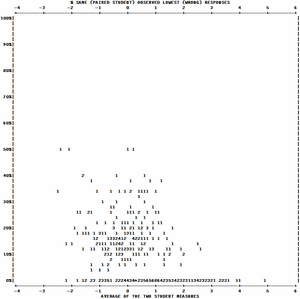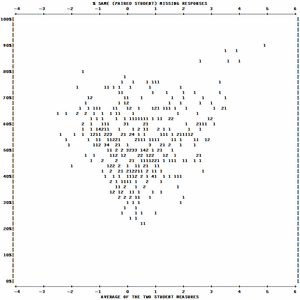(controlled by PSELECT=, ISELECT=, PSUBTOTAL=)
In Table 35, the response string for each person (row) is compared with the response string for every other person (row). The underlying details for Table 35 are reported in the AGREEFILE= file.
Sub-samples (groups of persons) can be specified with PSUBTOTAL=. Five plots are displayed for each sub-sample, unless the plot is empty.
When Table 35 is launched from the Output Tables menu, the Table 35 dialog box displays.
Table 35 |
x-axis: "Average of two person measures" = average of the ability measures for each pair of two persons. plotted values: 1-9 are counts of pairs at the x,y coordinates. * is more than 9 pairs. |
|
Table 35.x.1 y-axis: "% Same (paired student) observed responses" = the count of items for which both persons have the same response code in CODES= divided by the count of items for which both persons have a non-missing response %.
Table 35.1.1-5 - plots for the entire sample or for the accumulated subsamples selected by PSUBTOTAL= Table 35.2-x.1-5 - plots for subsamples selected by PSUBTOTAL=
Cheating detection: shared responses |
|
Table 35.x.2 y-axis: "% Same (paired student) scored responses" = the count of items for which both persons have the same score divided by the count of items for which both persons have a non-missing response %. |
|
Table 35.x.3 y-axis: "% Same (paired student) observed highest (right) responses" = the count of items for which both persons have the same highest scored response divided by the count of items for which one or both persons have a highest scored response %.
Cheating detection: shared knowledge |
|
Table 35.x.4 y-axis: "% Same (paired student) observed lowest (wrong) responses" = the count of items for which both persons have the same lowest scored response divided by the count of items for which one or both persons have a lowest scored response %.
Cheating detection: shared ignorance |
|
Table 35.x.5 y-axis: "% Same (paired student) missing responses" = the count of items for which both persons have a missing response divided by the count of items for which one or both persons have a missing response %. |
Example: For cheating-detection, see www.rasch.org/rmt/rmt61d.htm




